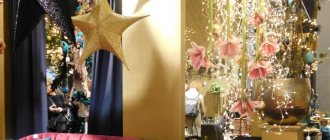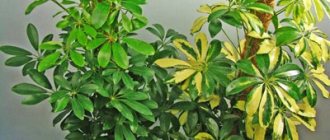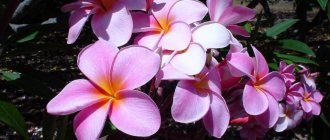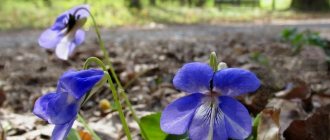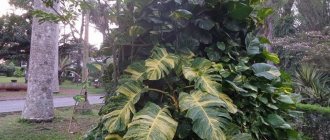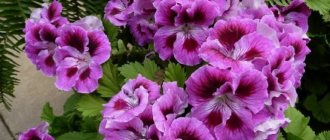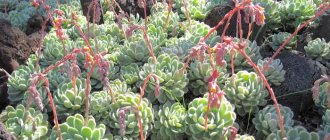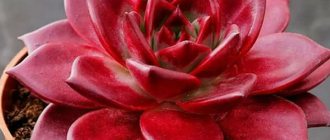Industrial grades
Culture lovers sometimes call such gloxinias stampings. Retail chains sell flowering bushes in transport containers and seeds. On the pack, in addition to the name of the series, the color of the corollas may be indicated, or there may be a “mix” mark, which means a mixture of colors.
Terry stampings may not be as elegant as the designer varieties, but on the whole they are no worse - bright and beautiful. But caring for them at home is easier.
Brocade
Japanese series, sometimes sold under the incorrect name Velvet f1. In fact, Brocade translates to “brocade.”
Brocard varieties have a small compact rosette, pointed velvety leaves, bell-shaped corollas with two rows of fused petals, and a short tube. Flowering is of bouquet type - the buds are concentrated in the center of the bush in a dense group, directed upward, and bloom together.
Today there are 6 varieties without names, differing in the color of the corolla. He can be:
- white;
- pink;
- red and purple - with white edging or plain.
Sonata
Dutch series with large double corollas and bouquet flowering. Available colors:
- pale pink;
- lilac;
- purple;
- coral;
- red;
- white.
The disadvantage of the Sonata series is that the bushes tend to stretch out, and it is not always possible to obtain an attractive rosette.
How many hybrids are there?
Gloxinia hybrids number more than 25 species. Plant varieties cannot be counted, as breeders are constantly developing new varieties. The most famous of them:
- Yesenia variety;
- variety Bohemia;
- variety Kaiser Wilhelm;
- variety Jasmine;
- Tidea group of varieties;
- variety Chance meeting;
- variety Wuthering Heights;
- Tigrina variety;
- Blue Pearl variety;
- Party Dude variety;
- Ozark Pink Popcorn variety;
- variety Sinningia leucotricha.
You may be interested in learning about the features of growing other varieties of gloxinia:
- Krasnoyarsk;
- White terry;
- pink;
- Shagane;
- Rosalind;
- Sonata;
- climbing variety;
- Brocades.
Solid Gloxinia
Oddly enough, it is precisely these terry varieties that are more difficult to find than tiger, calico or bicolor. The corollas are smoothly colored, pastel and saturated colors are pure, sometimes changing slightly from the center to the periphery of the corolla. Specks are allowed inside the throat. The petals are fused into a short tube, arranged in at least 2 rows.
Red, crimson and burgundy
Unlike Saintpaulias, Gloxinia corollas have a deep red color. Shades may vary depending on external conditions.
Desdemona
The flowers are large, cherry-beet, double, with fringed petals. The throat is open, white, speckled. The leaves are dark, with a silver tint and malachite veins.
Red viburnum
A very beautiful variety from V. Ivanov. The corollas are flat, almost scarlet, which is very rare in the world of flowers. The petals are slightly wavy, rounded or rectangular, arranged in several rows, whitish at the base and on the inside. The leaves are dark green.
Cheerful Girl
Gloxinia from E. Nikolaeva. The flowers are red-crimson. The petals have a wavy edge and are arranged in several rows; sometimes a barely noticeable speck appears, a tone darker than the main one.
Estasi
The flower is a real rose with burgundy, velvety, wavy petals and a full center. Looks amazing.
White
These gloxinias are distinguished by their clean, elegant coloring. But you need to care for them carefully. Any speck left after touching hot or cold glass, or from a drop of water falling on the rim while watering, is clearly visible.
Madonna
The famous white terry variety. Forms a compact rosette with dark leaves. The corollas are distinctly bell-shaped, with an elongated tube, strongly wavy edges of the petals, and a blurred yellow spot in the throat. Peduncles are long and weak.
For an adult bush in a pot, you need to provide support. You can plant Gloxinia Madonna in a hanging basket and grow it like an ampel.
White Lady
The flowers are double, symmetrical, with a pronounced tube and a light lemon spot at the entrance to the pharynx. Medium-sized bush with dark plates.
Whipped cream
Variety of Victor Ivanov. A double, rose-like gloxinia with a tightly packed flower. The color is not pure white, but seems to be slightly touched with pink.
Winter Light
Gloxinia semi-mini with double flowers, which in the photo seem skillfully made of plastic. In the center of the not very large roses you can see the lemon pharynx.
Purple and blue
Black gloxinias have always been one of the most popular. In fact, there cannot be such a color of the corollas; this is what deep purple varieties are called.
Madagascar
The plant is medium in size, with long peduncles, and at the peak of its decorative value requires supports. The corollas are large, terry, fringed, blue-violet.
The throat is open, white, speckled. Breeder – Tatyana Vysota.
Negress
The famous gloxinia from Natalia Grishina. Velvet flowers up to 12 cm in diameter appear blue-black. The leaves are greenish-olive.
To achieve a truly dark color, cool conditions and bright lighting are recommended.
black Jack
Dutch variety with bouquet flowering. The petals are double, wavy, dark purple.
The pharynx is open, white, with a pronounced vascular network, colored to match the main color.
Twilling of Day
Terry gloxinia semi-mini. The deep purple corollas with a white throat last a very long time.
Pink
The group includes gloxinias with terry corollas from delicate pastel colors to bright, rich ones. At the entrance to the pharynx, the pink color often thickens and becomes darker than on the petals.
Dolce Vita
Popular terry gloxinia with large, light, pastel pink corollas. The flower is flat, the throat is dark in color, wide open. The rosette is compact, the leaves are slightly bent downwards.
Peach Rose
Gloxinia pink has a beautiful rich color. The front side of the corolla seems velvety, the back side is satiny. The center remains covered for a long time with half-closed petals.
Pink Pleasure
The name of the terry variety translates as “pink pleasure.” The corollas are mother-of-pearl, wavy, gracefully bent. The hue inside the flower is bright, and towards the edge it turns into a blurry pink.
Mouse Ice
Gloxinia is known as Pink Flamingo. Peduncles are weak and need support. The corollas are large, terry, pink with a lilac tint. The edges of the petals are slightly lighter than the main tone.
Lilac and purple
A diverse group of terry gloxinias. Shades can vary greatly, be rich or subtle, very dark or washed out almost to white.
Deep Lake
Beautiful lilac gloxinia, the name translates as Dark Lake, in catalogs it can be found under the name “Nadezhda”. The flowers are large, and when fully opened, dark spots are visible inside the tube. The leaves are light.
Tamerlane
Original large-flowered double gloxinia with wavy petals. Dark veins stand out clearly against the lilac background.
The pharynx is white with greenish tint and includes sparse, chaotically scattered dots.
Mav Ice
The color of this terry Dutch gloxinia is indicated by the name - “Purple Ice”. The petals are wavy, slightly bent towards the underside, unevenly colored, with streaks of pink.
Ariel
A lilac-blue terry variety with uneven coloring and wide petals. The base of the corolla and throat are white, with sparse purple speckling deep in the tube.
Cold period
Considering the characteristics of gloxinia and how to care for this plant, it is worth noting that it needs complete rest during the cold period. This allows you to accumulate strength before the exhausting period of flowering. You should be prepared for the fact that the ground part of the flower completely dies with the onset of cold weather. If you do not know about this feature of gloxinia, it may scare you. But this is a normal process for this plant.
It is important to maintain the right conditions during the dormant period so that the roots do not die during the winter. In the spring, when the temperature begins to rise, gloxinia will send out its shoots again, preparing for the flowering period
Make sure that the temperature drops gradually. Do not allow sudden changes, as this will negatively affect the condition of the gloxinia root system. The first thing you need to do when the above-ground part of the plant completely dies is to stop watering the soil. During this period, gloxinia needs a minimum amount of moisture. Also avoid applying fertilizers.
Dried stems are carefully cut with a clean and sharp tool. You only need to leave small cuttings that will protrude above the surface of the soil in the pot. After this, you need to keep the soil dry. It must be permeable to air. Therefore, in August-September you need to loosen it a little. This must be done carefully so as not to damage the root system.
Next, the pot is transferred to a cool place. It should be dark enough here so that the plant does not wake up at the wrong moment. A place under the bathroom is suitable if your apartment is not very hot in winter. The pot is taken out onto the balcony if it is insulated. Even in severe frost, the temperature should not be below 11 °C.
To prevent the soil from becoming completely dry and lifeless, water gloxinia once a month in winter. But you don't need a lot of moisture. Therefore, do not flood the plant. It is enough to just slightly moisten the soil. At this stage, this is quite enough for a dormant gloxinia. It can be transplanted in this state into a larger pot. It is best to do this in the first month of the year. You can also update the substrate, making the soil more nutritious.
It happens that in winter gloxinia produces a small shoot. This is explained by the rather high temperature in the room where you left the pot with the dormant plant. If the root is strong, this is not a problem. Remove the shoot so that it does not take away the gloxinia's strength.
Terry gloxinia bicolor
Along the edge of the fused petals there is a thin or wide edge, sometimes blurred towards the center. The stripe can be contrasting or several shades darker than the main color. The throat is sometimes strewn with specks.
Fire of Innocence
Gloxinia is white, with a pronounced tube and a light yellow throat. The petals are wavy, decorated with a narrow, uneven, blue-blue edging.
When kept cool, the color of the strip becomes intense, but in the heat it fades. The leaves are light, the rosette is medium.
Strawberry Ice Cream
Full-double gloxinia. The flowers look like red roses with a white edge. The width of the border depends on external conditions; in hot summers it can become narrow. The petals are bent and come in large waves.
The buds are formed according to the bouquet type - in the center of the rosette, almost simultaneously.
Wild Plum
Terry white gloxinia from O. Artemova. The corolla is strictly double, open, with a lemon spot in the center. It is clearly noticeable that the petals are fused. Along the edge there is a wide lilac stripe, sometimes occupying most of the flower.
Ophelia
Delicate white petals are sinuous, edged along the edge with a narrow, blurry, very pale pink border. In places the edging is interrupted. Deep in the throat you can see purple specks.
Description of the plant
Gloxinia is a perennial stemless or short-stemmed plant.
Its shoots are fleshy, the leaves are large or small (depending on the species), ovoid in shape, dark green in color, and velvety. Flowers range from small to large, can be of different shapes, 1.5-12 cm in diameter, sometimes larger, usually corrugated along the edges. The color of Gloxinia flowers can vary. Dark purple ones are more common, but there are also pink, white, and closer to blue or red tones. Flowers can be single or multi-colored. 30-40 flowers bloom simultaneously on one plant. Of course, for this you need to choose a suitable variety and provide it with very good conditions for growth. Most often, about 8 flowers can be found on one bush at the same time. Flowering duration is approximately 3 months - from March to June, but this indicator may differ among different varieties.
Photos of Gloxinia
Calico terry
Gloxinias have interesting colors - the main background is covered with clearly visible dots or small bright peas. Calico white double flowers look especially elegant in the photo.
Constellation of Love
Gloxinia selection by E. Statsenko. Rare crimson-red peas are scattered on a snow-white background. There are no specks along the edge of the petals.
Cleopatra
A common variety. The white flowers are densely dotted with purple or dark purple dots. At the entrance to the wide throat they are grouped into longitudinal stripes.
The edges of the petals are wavy and lightened. The reverse side is white. The bush is neat, the peduncles are short.
Winter cherry
One of the most beloved calico gloxinias by collectors. According to the description, the variety is similar to the previous one, but it is impossible to confuse the plants standing next to it.
Winter Cherry bush - semi-mini, with small leaves. Snow-white corollas are strewn with ruby peas.
Fancy Bell
Bright pink gloxinia with double petals, densely dotted with crimson specks.
The pharynx is white, the dots inside it become very small.
Pest and disease control
Gloxinia most often suffers from cyclamen and spider mites. These are small pests that are difficult to see - in large numbers they rather resemble a coating or layer of dust. The leaves begin to deform and curl, and the buds wither. To combat parasites, use a solution of insecticides for flowering plants.
Another problem is thrips, which can be detected by the appearance of light spots on the leaves. In this case, in addition to treatment, it is necessary to replace the entire top layer of soil, because this is where the pest lays its larvae.
If brown rot appears on the leaves, the damaged areas should be immediately removed and treated with fungicides. Root rot is more difficult - most often it can be detected when the stem begins to deteriorate. In this case, it is almost impossible to save the flower. Therefore, be sure to monitor watering, do not overwater gloxinia and do not use too cold water.
Photo: pocvetam.ru
Terry tigers
Demanded, spectacular gloxinias combine the characteristics of the bicolor and calico groups. The list of varieties is updated annually.
Anfisa
One of the most famous terry tiger, authored by N. Tkachenko. The corolla is symmetrical, on a small thick tube, white with bright crimson specks and a border. The rosette is compact, the peduncles are short.
Arabella
A fantastically beautiful variety from E. Statsenko. White double flowers are decorated with a very wide dark red, fringed, uneven border, and dense polka dots. The rosette is large, the peduncles are long.
Joker
Compact gloxinia with large double flowers. A wide inky border runs along the edge of the petals; the white background is dotted with purple specks.
In the pharynx, the points become smaller and “line up” in longitudinal stripes.
The Snow Queen
Stunning gloxinia with double wavy petals. The corolla is decorated with an uneven wide lilac-blue border and violet or dark purple small dots.
About the origin of the species
In the wild, this plant of the Gesneriev family has existed for a long time, hiding in the rocky crevices of Brazil and other countries of the Southern continent. At the end of the 18th century, a scientist from Germany, Benjamin Peter Gloksin, came across a small plant with bright, beautiful speckled flowers. He brought a new species to Europe, giving the flower his name.
Gloxinia beauties
Gloxinia settled on the windowsills of houses and began to be grown in greenhouses. To create varieties, breeders were only suitable for 2 species: royal gloxinia and beautiful. But they were also able to provide a gorgeous floral variety that pleases the eye.
A few decades after the Latin American plant came to Europe, another scientist, Wilhelm Sinning, discovered a flower unfamiliar to him in his greenhouse. Having started growing it, the botanist gave the plant the name “sinningia”, not suspecting that the crop had already been called gloxinia.
Compact Sinningia
Terry gloxinias out of categories
The color of the corollas of some varieties cannot be classified into any one group, but they deserve to take an honorable place in any collection. There are more such gloxinias every year.
Rose of Narnia
Variety from E. Nikolaeva. The white rim is decorated with a wide, uneven edging and marble veins of the same color.
Depending on growing conditions:
- the border can be soft lilac-blue or inky;
- the pattern takes up most of the rose-like flower, or unobtrusively runs along the edge of the petals.
Resort girl
This variety is somewhat reminiscent of an orchid. The corolla consists of two flowers seemingly inserted into each other, the third row represents rudimentary rudiments of petals covering the entrance to the light yellow pharynx. The color is crimson, the surface is covered with a thick vascular network of a darker shade.
Glamor
The second name of the variety is Lady Jane. The snow-white flowers open wide when they bloom and have pink or crimson markings.
They look like specks or a vascular network and cover a small part of the surface of the petals. May not be present on all corollas.
Business on this plant
The gloxinia business is beautiful, mostly amateur and mostly seasonal, during flowering, although the seeds, if there are sufficient quantities, can be sold all year round. Even in small towns there is consistently good demand for gloxinia. They sell tubers, seeds, rooted cuttings and leaves; adult flowering plants - only in specialized stores.
In order for the gloxinia business to be successful, you will have to not only learn everything about them, but also allocate a separate room for flowers, purchase shelving and fluorescent lamps, and, if possible, make a page on the Internet with a photo and price list. It is necessary to have a large assortment of different types and colors of this flower, since gloxinia lives for 3-4 years.
Landing
The plant is grown by seeds in a specially prepared mixture. It is necessary to use turf leaf soil, sand and humus. Before planting, the substrate is disinfected and watered. The procedure must be completed in March. Procedure:
- Plant the seeds in a container at a distance of 3-4 cm from each other and cover with film.
- Move the container to a warm place and moisten the soil regularly.
- When the first leaves appear, move the seedlings to separate pots.
- Place the flowers in a warm, bright place and water them regularly.
What does terry gloxinia look like - types of flowers
The bush should begin to bloom in six months.
Important! When watering, it is advisable to pour water not into the pot itself, but into the tray.
Planting seeds
